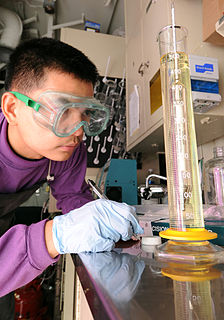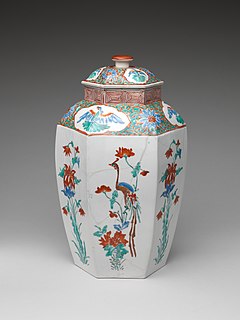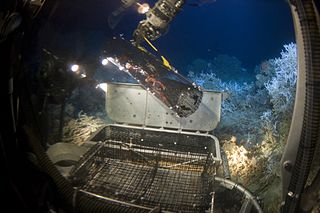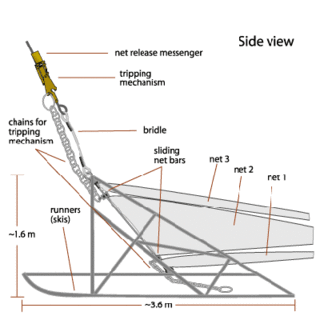
Relative density, or specific gravity, is the ratio of the density of a substance to the density of a given reference material. Specific gravity for liquids is nearly always measured with respect to water at its densest ; for gases, the reference is air at room temperature. The term "relative density" is often preferred in scientific usage.

Laboratory glassware refers to a variety of equipment used in scientific work, and traditionally made of glass. Glass can be blown, bent, cut, molded, and formed into many sizes and shapes, and is therefore common in chemistry, biology, and analytical laboratories. Many laboratories have training programs to demonstrate how glassware is used and to alert first–time users to the safety hazards involved with using glassware.

A bottle is a narrow-necked container made of an impermeable material in various shapes and sizes to store and transport liquids and whose mouth at the bottling line can be sealed with an internal stopper, an external bottle cap, a closure, or a conductive "inner seal" using induction sealing. Some of the earliest bottles appeared in China, Phoenicia, Crete, and Rome.

Vagn Walfrid Ekman was a Swedish oceanographer.

A jar is a rigid, cylindrical or slightly conical container, typically made of glass, ceramic, or plastic, with a wide mouth or opening that can be closed with a lid, screw cap, lug cap, cork stopper, roll-on cap, crimp-on cap, press-on cap, plastic shrink, heat sealed lidding film, an inner seal, a Tamper-evident band, or other suitable means.

Gas blending for scuba diving is the filling of diving cylinders with non-air breathing gases such as nitrox, trimix and heliox. Use of these gases is generally intended to improve overall safety of the planned dive, by reducing the risk of decompression sickness and/or nitrogen narcosis, and may improve ease of breathing.

A core sample is a cylindrical section of (usually) a naturally-occurring substance. Most core samples are obtained by drilling with special drills into the substance, such as sediment or rock, with a hollow steel tube, called a core drill. The hole made for the core sample is called the "core hole". A variety of core samplers exist to sample different media under different conditions. More continue to be invented on a regular basis. In the coring process, the sample is pushed more or less intact into the tube. Removed from the tube in the laboratory, it is inspected and analyzed by different techniques and equipment depending on the type of data desired.

The Ekman layer is the layer in a fluid where there is a force balance between pressure gradient force, Coriolis force and turbulent drag. It was first described by Vagn Walfrid Ekman. Ekman layers occur both in the atmosphere and in the ocean.

Sea glass and beach glass are similar but come from different types of waters. "Sea glass" is physically and chemically weathered glass found on beaches along bodies of salt water. These weathering processes produce natural frosted glass. "Genuine sea glass" can be collected as a hobby and is used for decoration, most commonly in jewelry. "Beach glass" comes from fresh water and in most cases has a different pH balance and a less frosted appearance than sea glass. Sea glass takes 20 to 40 years, and sometimes as much as 100 to 200 years, to acquire its characteristic texture and shape. It is also colloquially referred to as "drift glass" from the longshore drift process that forms the smooth edges. In practice, the two terms are used interchangeably.

Geotechnical investigations are performed by geotechnical engineers or engineering geologists to obtain information on the physical properties of soil earthworks and foundations for proposed structures and for repair of distress to earthworks and structures caused by subsurface conditions. This type of investigation is called a site investigation. Additionally, geotechnical investigations are also used to measure the thermal resistivity of soils or backfill materials required for underground transmission lines, oil and gas pipelines, radioactive waste disposal, and solar thermal storage facilities. A geotechnical investigation will include surface exploration and subsurface exploration of a site. Sometimes, geophysical methods are used to obtain data about sites. Subsurface exploration usually involves soil sampling and laboratory tests of the soil samples retrieved.
Subsea is fully submerged ocean equipment, operations or applications, especially when some distance offshore, in deep ocean waters, or on the seabed. The term is frequently used in connection with oceanography, marine or ocean engineering, ocean exploration, remotely operated vehicle (ROVs) autonomous underwater vehicles (AUVs), submarine communications or power cables, seafloor mineral mining, oil and gas, and offshore wind power.

Deep-sea exploration is the investigation of physical, chemical, and biological conditions on the sea bed, for scientific or commercial purposes. Deep-sea exploration is considered a relatively recent human activity compared to the other areas of geophysical research, as the depths of the sea have been investigated only during comparatively recent years. The ocean depths still remain a largely unexplored part of the planet, and form a relatively undiscovered domain.
A subsurface current is an oceanic current that runs beneath surface currents. Examples include the Equatorial Undercurrents of the Pacific, Atlantic, and Indian Oceans, the California Undercurrent, and the Agulhas Undercurrent, the deep thermohaline circulation in the Atlantic, and bottom gravity currents near Antarctica. The forcing mechanisms vary for these different types of subsurface currents.

The paravane is a towed winged (hydrofoiled) underwater object—a water kite. Paravanes have been used in sport or commercial fishing, marine exploration and industry, sports and military. The wings of paravanes are sometimes in a fixed position, else positioned remotely or by actions of a human pilot. Pioneer parafoil developer Domina Jalbert considered water kites hardly different from air kites. However, paravanes generally orient themselves in respect to the water surface. They may have sensors that record or transmit data or be used entirely for generating a holding force like a sea anchor does. While a sea-anchor allows a vessel to drift more slowly downwind, the paravane travels sideways at several times the downwind speed. Paravanes are, like air kites, often symmetrical in one axis and travel in two directions, the change being effected by gybing, shunting, or flipping over.
This is a glossary of terms used in fisheries, fisheries management and fisheries science.

A CTD or Sonde is an oceanography instrument used to measure the conductivity, temperature, and pressure of seawater. The reason to measure conductivity is that it can be used to determine the salinity.
A bathometer is an instrument for measuring water depth. It was previously used mainly in oceanographical studies, but is rarely employed nowadays. The term originates from Greek βαθύς (bathys), "deep" and μέτρον (métron), "measure".

An Epibenthic sled is an instrument designed to collect benthic and benthopelagic faunas from the deep sea. The sled is made from a steel frame consisting of two skids and stabilizing planes to keep it from sinking too deep into the mud. Attached to the frame is a 1 mm mesh net to collect the samples. The sled is towed along the seafloor at the sediment water interface. The device has a mechanically operated door that is closed when the sled is mid water and opens when it reaches the seafloor. When the fauna is collected, the door closes again to preserve the sample on the long trek back through the water column. The door prevents washing of the sample and loss of organisms through turbulence generated as the net is lifted out. The epibenthic sled can also be used with external sensors and cameras.

The Van Veen grab sampler is an instrument to sample sediment in water environments. Usually it is a clamshell bucket made of stainless steel. Up to 20 cm deep samples of roughly 0.1 m2 can be extracted with this instrument. It can be light-weight and low-tech. The smallest version even fits into hand luggage. The sampler was invented by Johan van Veen in 1933.

A rosette sampler is a device used for water sampling in deep water in order to investigate about its quality.
















